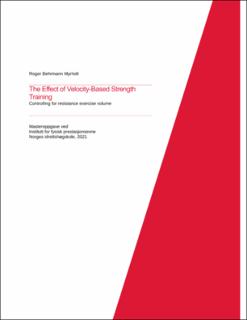| dc.description.abstract | Introduction: Velocity-Based Strength training (VBST) is based on measuring bar velocity. This allows for an objective prescription of relative load through the load-velocity relationship and level of effort through the magnitude of relative velocity loss within a training set. Previous studies that employed the squat have investigated the difference between low- (0%/10%/15%/20%) and high (30/40%) velocity losses with an equal amount of sets. These investigations have revealed that low and high velocity losses promote equal strength gains. Furthermore, high velocity losses are superior for hypertrophy and low velocity loss are superior for the development of jumping ability. However, the application of low- and high velocity losses have given rise to unequal resistance exercise volumes. Because resistance exercise volume is an important determinant for training adaptation, the purpose of this investigation was to equalize resistance exercise volume and investigate if this would promote greater strength increases for low velocity losses. Additionally, would similar resistance exercise volume equalize hypertrophy regardless of low or high velocity losses?
Methods: 22 participants were randomized and allocated into either a high velocity loss group (HVLG; 40% [squat] and 60% [bench-press]), or a low velocity loss group (LVLG; 20% [squat] and 30% [bench-press]) in the squat and bench-press. The LVLG completed additional sets to match the resistance exercise volume of the HVLG. The participants trained with a frequency of three times per week for six weeks. Of the 22 subjects that were recruited 16 completed the entire intervention. Pre-tests for strength, hypertrophy and jumping performance tests were conducted before initiation and 72 hours after the training period. Additionally, V1 – load (the weight that can be moved at 1 m/s) maximal effort strength tests were completed prior to every training session. Hypertrophy was assessed using ultrasound thickness measurement of the m. vastus lateralis and m. triceps brachii lateral head, and a DXA scan for full body assessment. Magnitude Based Statistics was employed to investigate the statistical and practical significance of the results, with and without co-variables.
Results: Both groups had a small clear increase in strength for all variables, with the exception of a clear trivial increase in bench-press 1RM for the LVLG. Meanwhile all DXA variables showed clear trivial changes in lean mass for both groups. Ultrasound showed clear trivial changes in thickness for m. triceps brachii lateral head and m. vastus lateralis for the LVLG, while the HVLG showed clear small increases for both muscles investigated. There were clear trivial differences for both strength and DXA measured lean mass between the groups. However, when statistically controlling for resistance exercise volume the 1RM squat results changed from trivial and clear to small and clear in favor of the LVLG. Furthermore, there was a small clear difference between the groups in thickness for the m. vastus lateralis in favor of HVLG, but only a trivial clear difference for the m. triceps brachii lateral head.
Discussion and conclusion: The purpose of this study was to investigate the effect of low velocity losses vs. high velocity losses in promoting strength gains and hypertrophy, when resistance exercise volume is controlled for. The reason we did not see superior increases in strength for the LVLG may be that the dose-response relationship of strength to resistance exercise volume may require each set to be carried out with a certain level of effort that the LVLG did not reach. However, the results show that when statistically controlling for resistance exercise volume the LVLG would have exceeded the HVLG, possibly indicating that the resistance exercise volume was not adequately equalized. Furthermore, we speculate that the metabolic stress associated with the high velocity losses in combination with the mechanical loading created a hypertrophy stimulus for the HVLG that exceeded the LVLG. Peculiarly, high velocity losses did not promote superior hypertrophy for the m. triceps brachii lateral head. This may be explained by the differences of the pattern of velocity loss between the squat and the bench-press. We conclude that low velocity losses provide no additional strength gain over high velocity losses. Furthermore, if hypertrophy is desired high velocity losses are superior to low velocity losses. | en_US |
